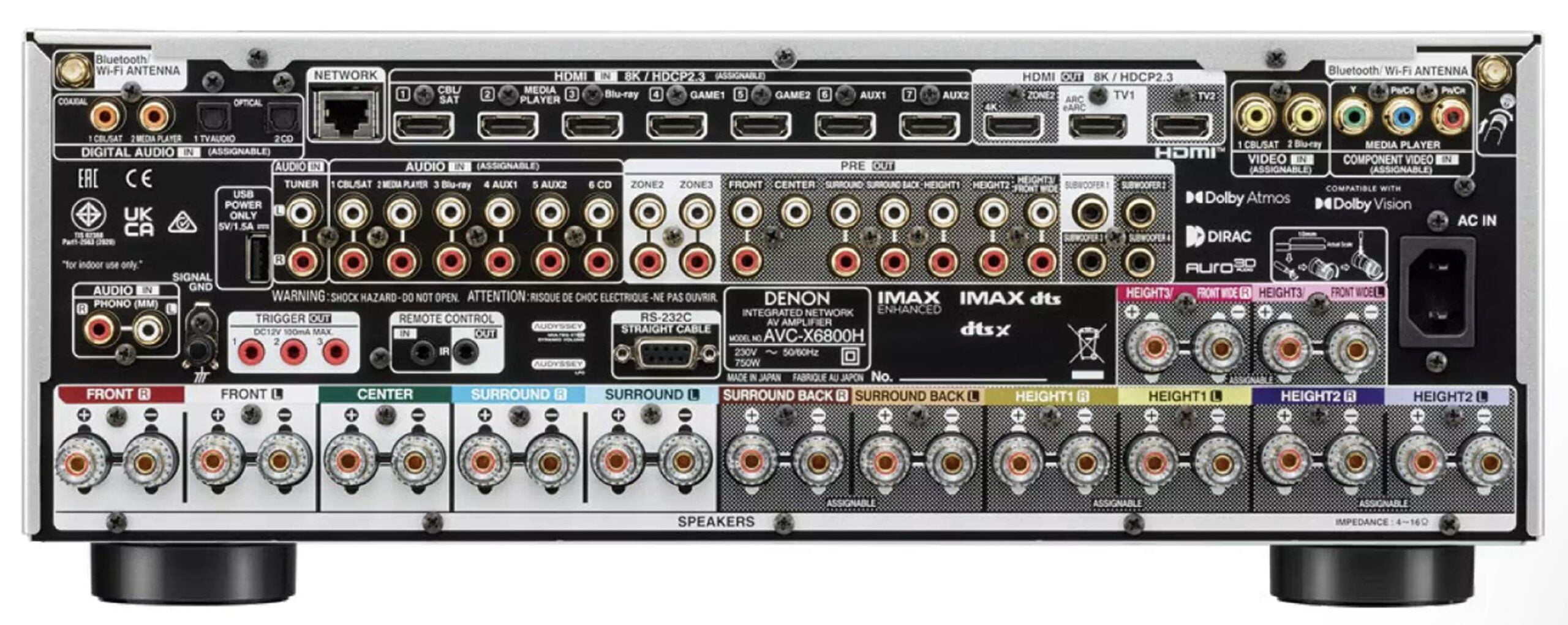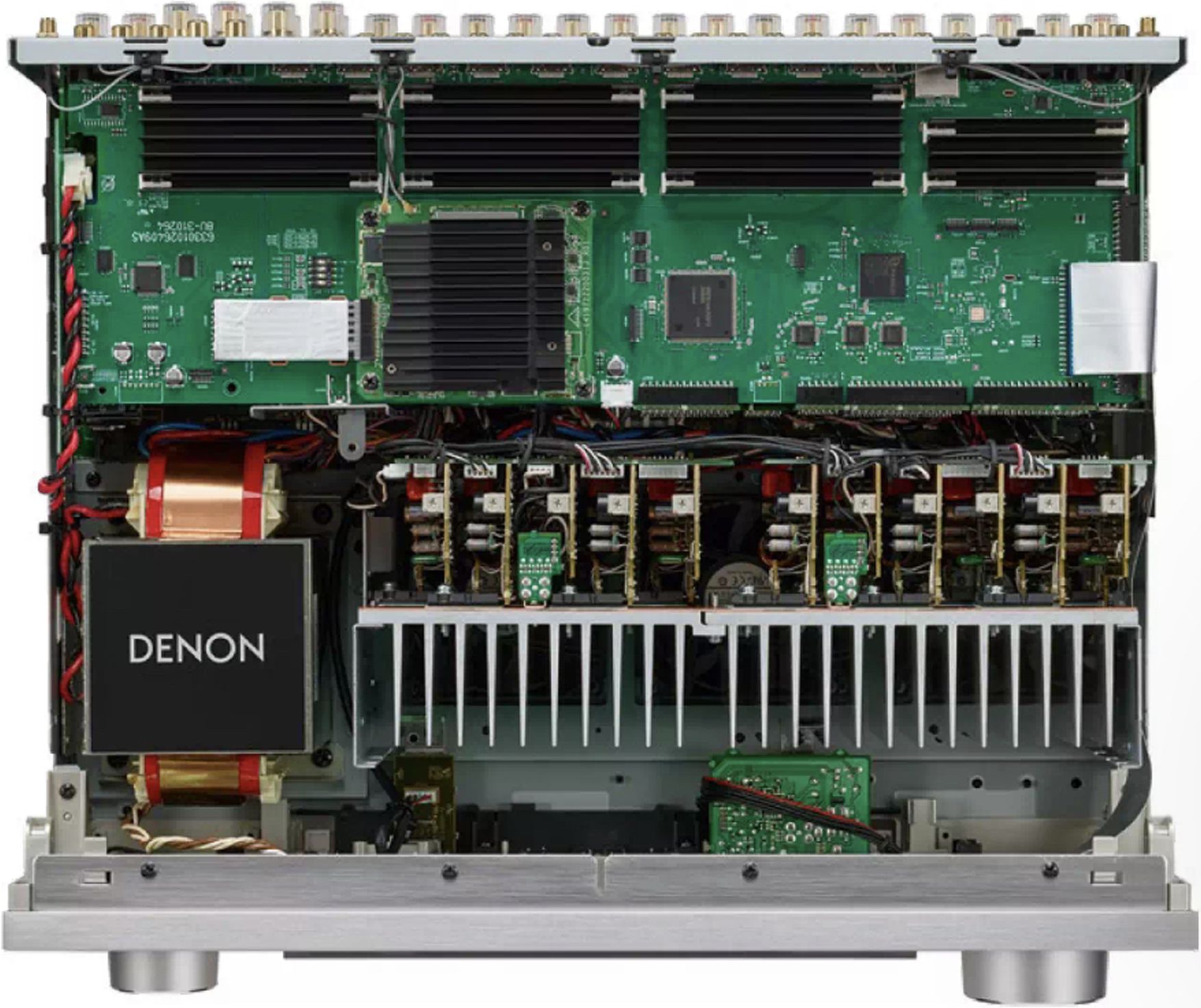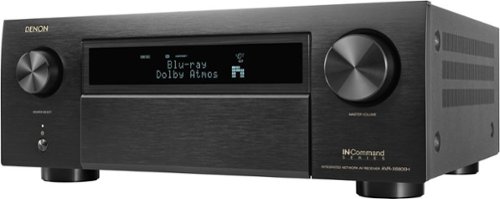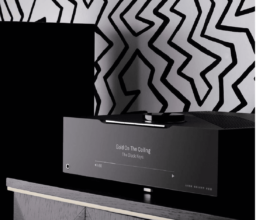Denon AVC-X6800H Review
The Denon AVC-X6800H promises flexible and powerful 3D sound reproduction. It also offers some interesting features for visual content. Let’s dive into what it has to offer. Tested at 3,500 Euros.
by Simon Mendel, Thomas Kirsche

When it comes to home theater AV receivers, almost every enthusiast thinks of Denon first. The Japanese manufacturer has been at the forefront of this field for decades, offering a wide range of products. Denon’s lineup includes everything from 5.2 to 15.4 AV receivers—there’s something for everyone. Beyond home theater, Denon consistently impresses with its musical tuning and high-quality devices.
In this review, we explore one of the largest AV receivers: the AVC-X6800H, which features 13.4-channel processing and 11-channel amplification, priced at 3,500 Euros.
11.4 or 13.4?
Denon makes it a bit tricky to understand whether the AVC-X6800H is a 13.4 or 11.4 receiver. Both specifications appear in the product description. A closer look reveals that the AVC-X6800H can process 13.4 channels, but its built-in amplifiers can only power 11 channels. To utilize all 13 channels, an external two-channel amplifier is needed. To avoid confusion, we’ll refer to it as an 11-channel receiver.
Classic Design
The Denon AVC-X6800H features a metal chassis that follows the classic HiFi component design. A few screws allow for easy access to the interior for repairs or cleaning. It’s refreshing to see Denon sticking with this tried-and-true construction, especially in an era where more devices are sealed and non-repairable.
The front is almost iconic, with two large rotary knobs for input selection and volume control. The right knob is slightly larger than the left. Both feel durable and well-made. Another hallmark of Denon’s AV receivers is the wide display between the knobs, which is bright, dimmable, and displays information like source, format, and volume.
Since you can’t operate an AV receiver with just two knobs, there are additional buttons hidden behind a flap on the front. The flap opens easily and slides under the device instead of hanging awkwardly. Behind it, you’ll find more buttons and three connectors: a USB-A port for a flash drive, a 6.3mm headphone jack, and a mini-jack labeled “Setup Mic,” where you connect the microphone for room calibration. We’ll cover that later in the review.
Remote Control and App
In a home theater or living room, you don’t want to control everything directly on the device. That’s why a remote control is included, allowing quick access to essential functions. Unfortunately, this remote is less comprehensive than other Denon remotes. Some buttons, like those for Eco mode, are missing and require you to navigate the menu instead. Alternatively, you can control the Denon AVC-X6800H with the HEOS app, Denon and Marantz’s app that integrates device control, streaming, and multiroom functions. In addition to HEOS, the Denon AV receiver is compatible with Apple AirPlay 2 and Google Chromecast.

Connectivity Options
The back of the AVR is packed with connections, almost the entire surface is utilized. At the top are the video inputs. As a HiFi website, we focus on the sound of a device. However, with AV receivers, good video quality is also crucial. The Denon AVC-X6800H includes seven 8K HDMI inputs and three outputs. The primary HDMI output supports eARC, offering enhanced audio return channel capabilities, including HiRes Audio, Dolby Atmos, and other high-resolution audio formats.

Additionally, there is a TV 2 output and a Zone 2 output. The latter supports only 4K and is intended for multiroom use. Besides the seven HDMI inputs, there are two RCA video inputs and one component video input. To provide flexibility on the digital front, the Denon AVC-X6800H includes two coaxial and two optical digital inputs.
For connecting analog peripherals, there are seven pairs of RCA inputs. You can also connect a turntable with an MM cartridge to the dedicated phono input. Next to the analog RCA inputs are the RCA outputs, with one pair each for Zone 2 and Zone 3, which are intended for multiroom applications. Additionally, there are pre-outs for 13 speakers and four subwoofer outputs. The pre-outs allow for external amplifiers to be connected if you want to use all 13 channels.

Thanks to the four available subwoofers, any bass problem in your home theater should be solved. Of course, the Denon AVC-X6800H also has its own amplifier section. It includes 13 pairs of speaker terminals to accommodate various speaker configurations. However, note that the AV receiver has only an 11-channel amplifier. All connections are well-made. But that’s not all in terms of connectivity on the Denon AV receiver. It also includes three trigger outs, a USB-A port for powering an external device, a remote control in and out, and an RS-232C port, allowing the AV receiver to be integrated into media control systems.
The Denon AV receiver is extremely flexible. Most inputs and outputs can be freely assigned, allowing you to decide what the speaker outputs or pre-outs should deliver.
Feature Density
The speakers are powered by 205 watts each (6 ohms) from the Denon AVC-X6800H. The receiver has a power supply rated at 750 watts, meaning not all channels can simultaneously deliver 205 watts. The 11-channel amplifier is designed in mono, allowing for dynamic and precise performance. To process incoming digital signals, Denon has equipped the AVC-X6800H with a new digital-to-analog converter board. This newly developed board includes extensive sound tuning and supports resolutions up to 192kHz sampling rate with 32-bit depth and DSD at 5.6MHz.
Regarding video playback, the Denon AVC-X6800H is fully equipped. In addition to 8K pass-through, it supports 8K upscaling and HDCP 2.3. It can also process high dynamic range content like HDR, HLG, Dynamic HDR, and HDR10+, with Dolby Vision also supported.
Primarily, the AVC-X6800H is a 3D audio specialist with various decoders for formats such as Dolby Atmos, DTS Pro, IMAX Enhanced, Auro 3D, and MPEG-H (360 Reality Audio). With this selection, immersive home cinema is well within reach. Moreover, it supports upmixers like Dolby Surround, DTS Neural
, and Auro-Matic, which optimize older, non-immersive content and upconvert it to 3D audio.
Easy Setup
After exploring the extensive feature list, let’s finally get to the practical side. The Denon AVC-X6800H is designed for modern, immersive home cinema. For our test, we set up the device in the large cinema hall of Auerbach Verlag. We connected it to the passive Dolby Atmos system from Monitor Audio (model: Cinergy).
Once everything was connected, the Denon AVC-X6800H automatically starts in setup mode. Here, we configure the receiver before diving into home cinema enjoyment. The setup process is user-friendly, even for absolute beginners. The AV receiver guides you step by step, explaining everything from connecting HDMI cables to speakers. Thanks to the well-structured and smart setup, nothing can go wrong. The AV receiver even detects if the speakers are connected incorrectly.
The final step in the setup process is room calibration. The Denon AVC-X6800H is compatible with room correction systems Dirac, Dirac Live, and Audyssey. Audyssey is included in the package, along with a microphone that plugs into the front input. The small microphone can be mounted on a tripod or placed on the included cardboard stand, which resembles a rocket with the microphone at the tip.
Room calibration with Audyssey is as straightforward as the setup itself. We go through eight measurement cycles, each at different locations around the listening position. Afterward, we can review the results. The calibration effectively counters room modes and generally improves sound balance. In our case, Audyssey slightly boosts the bass and raises the volume of the surround and ceiling speakers. Even without calibration, the Denon sounds great, but Audyssey extracts an extra 10% of sound quality. Truly effective!
Lights, Camera, Action!
As Star Wars and Indiana Jones director George Lucas once said, sound is at least 50% of the film experience. Comparing cinema, home cinema, and TV sound, we might rate the importance of sound even higher. Certain films, like the action blockbuster “Godzilla II: King of the Monsters,” benefit significantly from immersive, impactful sound. The 2019 sci-fi action film is set in a world where titans, giant monsters like Godzilla, exist and reawaken due to environmental destruction and human greed. This Kaiju spectacle thrives on its impressive, immersive film sound.
The sound is mixed in Dolby Atmos, and with Dolby Vision, the picture is incredibly vivid. The sound is equally precise and engaging. Explosions, music, dialogue—everything fits perfectly. Thanks to room calibration, the speakers sound even clearer and cleaner. The subwoofer is more focused, giving the dialogue more space. The AV receiver also demonstrates excellent dynamics, always balanced and clean, without appearing to struggle in filling the cinema hall. The battles between monsters and humans are truly immersive, and the three-dimensional soundscape surrounding us is convincing in all areas.
3D Music
But 3D audio isn’t just for films. There is an increasing amount of music being mixed for immersive formats. For example, the In-Side Mix of Peter Gabriel’s album “i/o.” We play the Dolby Atmos version of the album and experience the Denon in a different light. Now, we feel that Audyssey slightly distorts the sound image, and especially the surround and ceiling speakers seem too loud.
So, we disable the room calibration. We cycle through the sound modes and settle on “Direct.” Here, all sound adjustments are bypassed, and we experience the album in its purest form. Listening to music with a Dolby Atmos system is truly a different experience compared to stereo, especially since “i/o” is likely one of the best Dolby Atmos mixes out there. We dive even deeper into Peter Gabriel’s world of thoughts and sound. The vocals sound extremely natural and clear, and the instrumentation feels seamless. The AV receiver does an excellent job of conveying the three-dimensionality of the music. Here, 3D audio is not a gimmick but a real enhancement. You should definitely experience this yourself!
Specifications
Device Class:
AV Receiver
Price Category:
Upper class
Manufacturer:
Denon
Model:
AVC-X6800H
Price (MSRP):
€3500
Dimensions (W/H/D):
43.4×16.7×37.9 cm
Weight:
15.6 kg
Information:
www.denon.com
Power:
205W
Max Channels:
11 amplifier channels, 13 speakers (11.4)
Individual Sound Settings:
Yes
Multichannel Audio Formats:
Atmos, Auro 3D, IMAX Enhanced, DTS:X
Wireless Audio Connection:
Airplay 2, Chromecast, HEOS
Inputs:
7x HDMI, 2x coaxial, 2x optical, 2x video, component, 7x RCA, Phono MM
Outputs:
3x HDMI, 13x pre-out, 4x sub-out, 13x speaker
Conclusion
The Denon AVC-X6800H is a 3D audio specialist. It supports almost all formats and comes with a multitude of inputs and outputs, many of which can be freely assigned. The operation and especially the setup are intuitive and easy to follow. Additionally, the Denon AVR impresses with its sound quality. Whether with or without room calibration, it’s truly cinema at home!
Highlights
- Supports virtually all audio and video formats
- Automatic room calibration
Playback Quality:
57/60
Features/Build Quality:
15/15
User-Friendliness:
14/15
Adjustments:
None
Intermediate Result:
86 out of 90 points
Price/Performance:
Very good 9/10
Overall Result:
Reference Class 95%
When you purchase through links on our site, I may earn an affiliate commission. Here’s how it works.
Denon AVR-X6800H 11.4CH Best in Class AV Receiver?!?
In this video, we sit down with Phil Jones, Director of Global Brand Activation at Masimo Consumer to talk about the NEW Denon ...









